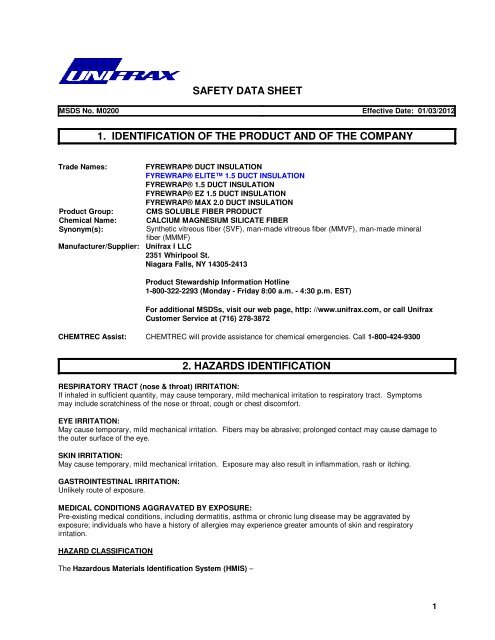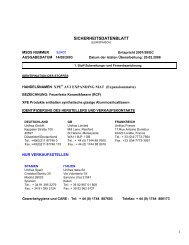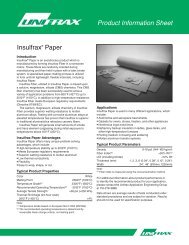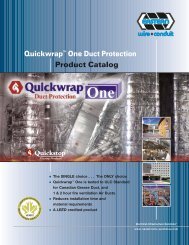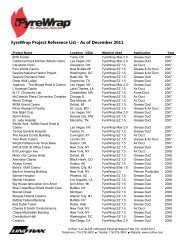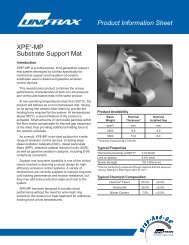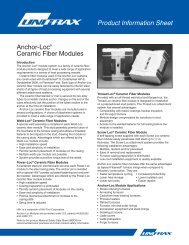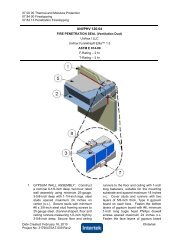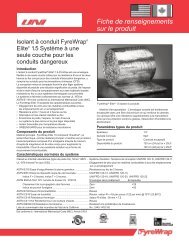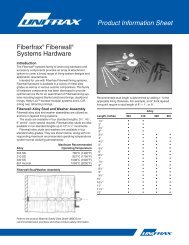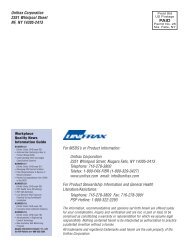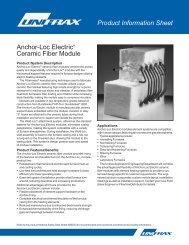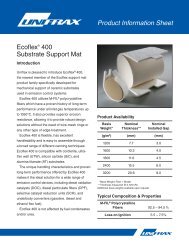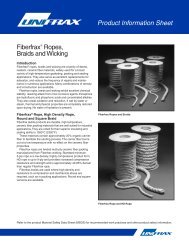Elite 1.5 Material Safety Datasheet - Unifrax
Elite 1.5 Material Safety Datasheet - Unifrax
Elite 1.5 Material Safety Datasheet - Unifrax
Create successful ePaper yourself
Turn your PDF publications into a flip-book with our unique Google optimized e-Paper software.
SAFETY DATA SHEETMSDS No. M0200 Effective Date: 01/03/20121. IDENTIFICATION OF THE PRODUCT AND OF THE COMPANYTrade Names:Product Group:Chemical Name:Synonym(s):Manufacturer/Supplier:FYREWRAP® DUCT INSULATIONFYREWRAP® ELITE <strong>1.5</strong> DUCT INSULATIONFYREWRAP® <strong>1.5</strong> DUCT INSULATIONFYREWRAP® EZ <strong>1.5</strong> DUCT INSULATIONFYREWRAP® MAX 2.0 DUCT INSULATIONCMS SOLUBLE FIBER PRODUCTCALCIUM MAGNESIUM SILICATE FIBERSynthetic vitreous fiber (SVF), man-made vitreous fiber (MMVF), man-made mineralfiber (MMMF)<strong>Unifrax</strong> I LLC2351 Whirlpool St.Niagara Falls, NY 14305-2413Product Stewardship Information Hotline1-800-322-2293 (Monday - Friday 8:00 a.m. - 4:30 p.m. EST)For additional MSDSs, visit our web page, http: //www.unifrax.com, or call <strong>Unifrax</strong>Customer Service at (716) 278-3872CHEMTREC Assist: CHEMTREC will provide assistance for chemical emergencies. Call 1-800-424-93002. HAZARDS IDENTIFICATIONRESPIRATORY TRACT (nose & throat) IRRITATION:If inhaled in sufficient quantity, may cause temporary, mild mechanical irritation to respiratory tract. Symptomsmay include scratchiness of the nose or throat, cough or chest discomfort.EYE IRRITATION:May cause temporary, mild mechanical irritation. Fibers may be abrasive; prolonged contact may cause damage tothe outer surface of the eye.SKIN IRRITATION:May cause temporary, mild mechanical irritation. Exposure may also result in inflammation, rash or itching.GASTROINTESTINAL IRRITATION:Unlikely route of exposure.MEDICAL CONDITIONS AGGRAVATED BY EXPOSURE:Pre-existing medical conditions, including dermatitis, asthma or chronic lung disease may be aggravated byexposure; individuals who have a history of allergies may experience greater amounts of skin and respiratoryirritation.HAZARD CLASSIFICATIONThe Hazardous <strong>Material</strong>s Identification System (HMIS) –1
Health 1 Flammability 0 Reactivity 0 Personal Protection Index: X (Employer Determined)3. COMPOSITION / INFORMATION ON INGREDIENTSSTANDARD PRODUCT FORMCOMPONENT CAS NUMBER % BY WEIGHTAmorphous calcium-magnesium-silicate(alkaline-earth-silicate) fiber436083-99-7 100ENCAPSULATED PRODUCT FORMCOMPONENTS CAS NUMBER % BY WEIGHTAmorphous calcium-magnesium-silicate(alkaline-earth-silicate) fiber436083-99-796-98Aluminum foil with fiberglass reinforcement andinorganic adhesive.FIBER CHEMISTRYNOT APPLICABLE2-4Amorphous calcium-magnesium-silicate (alkaline-earth-silicate), produced and sold separately under the tradename Insulfrax® Thermal Insulation Products.(SiO262-67 %, CaO 28-33 %, MgO 1-6 %, trace elements 0-1%)(See Section 8 "Exposure Controls / Personal Protection" for exposure guidelines)FIRST AID PROCEDURES4. FIRST AID MEASURESRESPIRATORY TRACT (nose & throat) IRRITATION:If respiratory tract irritation develops, move the person to a dust free location. Get medical attention if the irritationcontinues. See Section 8 for additional measures to reduce or eliminate exposure.EYE IRRITATION:If eyes become irritated, flush immediately with large amounts of lukewarm water for at least 15 minutes. Eyelidsshould be held away from the eyeball to ensure thorough rinsing. Do not rub eyes. Get medical attention ifirritation persists.SKIN IRRITATION:If skin becomes irritated, remove soiled clothing. Do not rub or scratch exposed skin. Wash area of contactthoroughly with soap and water. Using a skin cream or lotion after washing may be helpful.GASTROINTESTINAL IRRITATION:If gastrointestinal tract irritation develops, move the person to a dust free environment.NOTES TO PHYSICIANS:Skin and respiratory effects are the result of temporary, mild mechanical irritation; fiber exposure does not result inallergic manifestations.2
5. FIRE FIGHTING MEASURESNFPA Codes: Flammability: 0 Health: 1 Reactivity: 0 Special: 0NFPA Unusual Hazards:Flammable Properties:Flash Point:Hazardous Decomposition Products:Unusual Fire and Explosion Hazard:Extinguishing Media:NoneNoneNoneNoneNoneUse extinguishing media suitable for type of surrounding fire6. ACCIDENTAL RELEASE MEASURESSPILL PROCEDURESMinimize creating airborne dust. Dust suppressing cleaning methods such as wet sweeping or vacuuming shouldbe used to clean the work area. If vacuuming, the vacuum must be equipped with a HEPA filter. Compressed airor dry sweeping should not be used for cleaning.STORAGE7. HANDLING AND STORAGEStore in original container in a dry area. Keep container closed when not in use.HANDLINGHandle fiber carefully. Limit use of power tools unless in conjunction with local exhaust. Use hand tools wheneverpossible. Frequently clean the work area with HEPA filtered vacuum or wet sweeping to minimize the accumulationof debris. Do not use compressed air for clean-up.EMPTY CONTAINERSProduct packaging may contain residue. Do not reuse.8. EXPOSURE CONTROL / PERSONAL PROTECTIONINDUSTRIAL HYGIENE STANDARDS AND OCCUPATIONAL EXPOSURE LIMITSComponents OSHA MANUFACTURERCalcium-magnesium-silicate fiber None established* See below***There is no specific regulatory standard for INSULFRAX® in the U.S. OSHA’s “Particulate Not OtherwiseRegulated (PNOR)” standard [29 CFR 1910.1000, Subpart Z, Air Contaminants] applies generally; Total Dust 15mg/m³; Respirable Fraction 5 mg/m³.3
OTHER OCCUPATIONAL EXPOSURE LEVELS (OEL)ACGIH TLV's : Calcium-magnesium-silicate fiber -- Particulates Not Otherwise Classified (PNOC) : Inhalableparticulate -- 10 mg/m³. Respirable particulate -- 3 mg/m³.** Encapsulated Product Form: Encapsulation reduces (or eliminates) the potential for exposure to airborne fiber orparticles. If product is cut or otherwise disturbed, exposure may result.As with most industrial materials, it is prudent to minimize unnecessary exposure to respirable dusts. Note thatIndustrial hygiene standards and occupational exposure limits differ between countries and local jurisdictions.Check with your employer to identify any "respirable dust", "total dust" or "fiber" exposure standards to follow in yourarea. If no regulatory dust or fiber control standard apply, a qualified industrial hygiene professional can assistwith a specific evaluation of workplace conditions and the identification of appropriate respiratory protectionpractices. In the absence of other guidance, the supplier has found that it is generally feasible to controloccupational fiber exposure to 1 f/cc or less.ENGINEERING CONTROLS:Dust suppressing control technologies such as local exhaust ventilation, point of generation dust collection, downdraft work stations, emission controlling tool designs, and materials handling equipment are effective means ofminimizing airborne fiber emissions. For additional information, contact the <strong>Unifrax</strong> I LLC Product StewardshipInformation Line at 1-800-322-2293 (See Section 16).PERSONAL PROTECTION EQUIPMENTSkin Protection:Wear gloves, head coverings and full body clothing as necessary to prevent skin irritation. Washable or disposableclothing may be used. If possible, do not take unwashed clothing home. If soiled work clothing must be takenhome, employers should ensure employees are thoroughly trained on the best practices to minimize non-work dustexposure (e.g., vacuum clothes before leaving the work area, wash work clothing separately, rinse washer beforewashing other household clothes, etc.).Eye Protection:Wear safety glasses with side shields or other forms of eye protection in compliance with appropriate OSHAstandards to prevent eye irritation. The use of contact lenses is not recommended, unless used in conjunction withappropriate eye protection. Do not touch eyes with soiled body parts or materials. If possible, have eye-washingfacilities readily available where eye irritation can occur.Respiratory Protection:When effective engineering and/or administrative controls are insufficient, the use of appropriate respiratoryprotection, pursuant to the requirements of OSHA 1910.134, is recommended. For dust concentrations below theapplicable exposure limit value, PPE is not required. The evaluation of workplace hazards and the identification ofappropriate respiratory protection is best performed on a case by case basis, by a qualified Industrial Hygienist.9. PHYSICAL AND CHEMICAL PROPERTIESODOR AND APPEARANCE: White, odorless, fibrous materialCHEMICAL FAMILY:Calcium Magnesium Silicate FibersBOILING POINT:Not ApplicableWATER SOLUBILITY (%):Not Soluble in WaterMELTING POINT: 1260° C (2300° F)SPECIFIC GRAVITY: 2.60VAPOR PRESSURE:Not ApplicablepH:Not ApplicableVAPOR DENSITY (Air = 1): Not Applicable% VOLATILE: Not ApplicableMOLECULAR FORMULA:SiO2CaO.MgO.4
10. STABILITY AND REACTIVITYCHEMICAL STABILITY:INCOMPATIBILITY:CONDITIONS TO AVOID:HAZARDOUS DECOMPOSITION PRODUCTS:HAZARDOUS POLYMERIZATION:Stable under conditions of normal use.Avoid direct contact with strong acid environments.None.None.Not Applicable.11. TOXICOLOGICAL INFORMATIONEPIDEMIOLOGYThis product has not been the subject of epidemiological study. Epidemiological studies related to other fiberchemistries of similar solubility have not identified a statistically significant incidence of exposure-related respiratorydisease.TOXICOLOGYThis product has been the subject of limited testing.A review of available scientific literature suggests an inverse relationship between dissolution rate and potentialhealth effects; i.e. the higher the dissolution rate of a fiber the lower its potential to produce health effects. Thedissolution rate of INSULFRAX® fiber has been determined through standardized in vitro testing. The dissolutionrate of INSULFRAX® fibers is higher than that of other fiber types that have been tested in chronic animal studiesand did not produce respiratory disease.This product possesses a fiber chemistry within the regulatory (European Commission Directive 97/69/EC)definition as a "man-made vitreous (silicate) fiber with random orientation with alkaline oxide and alkaline earthoxide (Na2O + K2O + CaO + MgO + BaO) content greater than 18% by weight". INSULFRAX® fibers have beentested pursuant to EU protocol ECB/TM/26, rev. 7, Nota Q, Directive 97/69/EC. The results for the short termbiopersistence test by inhalation (IH test) was 7 days; well below the regulatory threshold of 10 days cited inDirective 97/69/EC. Based on testing results, INSULFRAX® based products are not regarded as potentialcarcinogens and they ARE EXEMPT from European classification as such. By virtue of these test results, theseproducts ARE EXEMPT from European regulatory guidelines that require hazard warning labels with specific riskphrases citing respiratory disease potential. In addition, INSULFRAX® fibers have been tested in an independentlaboratory, by intratracheal (IT test) instillation, under a protocol that was consistent with the requirements of theGerman Hazardous Substances Ordinance (BGBI. I pp. 1782, 2049, Third Amendment, Appendix V, No. 7). Thehalf-life clearance of INSULFRAX® fibers was 30 days; well below the applicable regulatory thresholds. Based onthe IT test results, INSULFRAX® products ARE EXEMPT from the requirements of the German Ordinance.The definition of "irritant" contained in the hazard communication standard, 29 CFR 1900.1200, Appendix A, is "...areversible inflammatory effect on living tissue by chemical action...". INSULFRAX® fiber is an inert material whichdoesn't interact chemically with exposed skin. However, there is a possibility that exposure to this product maycause temporary mechanical irritation to the eyes, skin or respiratory tract (nose, throat, lungs). This temporaryirritation can be mitigated with proper handling practices designed to limit exposure and the use of protectiveclothing (glasses, gloves, clothing).No ecological concerns have been identified.12. ECOLOGICAL INFORMATION13. DISPOSAL CONSIDERATIONS5
WASTE MANAGEMENTTo prevent waste materials from becoming airborne during waste storage, transportation and disposal, a coveredcontainer or plastic bagging is recommended.DISPOSALINSULFRAX® fiber, as manufactured, is not classified as a hazardous waste according to Federal regulations (40CFR 261). Any processing, use, alteration or chemical additions to the product, as purchased, may alter thedisposal requirements. Under Federal regulations, it is the waste generator's responsibility to properly characterizea waste material, to determine if it is a "hazardous" waste. Check local, regional, state or provincial regulations toidentify all applicable disposal requirements.EUROPEAN UNIONWaste from this product is not classified as “hazardous” or “special” under European Union regulations. Disposal ispermitted at landfills licensed for industrial waste.U.S. DEPARTMENT OF TRANSPORTATION (DOT)14. TRANSPORT INFORMATIONHazard Class: Not Regulated United Nations (UN) Number: Not ApplicableLabels: Not Applicable North America (NA) Number: Not ApplicablePlacards: Not Applicable Bill of Lading: Product NameINTERNATIONALCanadian TDG Hazard Class & PIN: Not regulatedNot classified as dangerous goods under ADR (road), RID (train) or IMDG (ship).UNITED STATES REGULATIONS15. REGULATORY INFORMATIONEPA: Superfund Amendments and Reauthorization Act (SARA) Title III - This product does notcontain any substances reportable under Sections 302, 304, 313, (40 CFR 372). Sections311 and 312 (40 CFR 370) apply (delayed hazard).Toxic Substances Control Act (TSCA) - All substances in this product are listed, asrequired, on the TSCA inventory.Comprehensive Environmental Response, Compensation and Liability Act (CERCLA)and the Clean Air Act (CAA) - INSULFRAX® contains fibers with an average diametergreater than one micron and thus is not considered a hazardous air pollutant.OSHA: Comply with Hazard Communication Standards 29 CFR 1910.1200 and 29 CFR 1926.59and the Respiratory Protection Standards 29 CFR 1910.134 and 29 CFR 1926.103.States: INSULFRAX® products are not known to be regulated. However, state and local OSHA andEPA regulations may apply to these products. If in doubt, contact your local regulatoryagency.INTERNATIONAL REGULATIONSCanada:Canadian Workplace Hazardous <strong>Material</strong>s Information System (WHMIS):No Canadian Workplace Hazardous <strong>Material</strong>s Information System (WHMIS) categories applyto this product.6
29 CFR 1910.1200 & 1926.59: OSHA Hazard Communication StandardsPEL:Permissible Exposure Limit (OSHA)PIN:Product Identification NumberPNOC:Particulates Not Otherwise ClassifiedPNOR:Particulates Not Otherwise RegulatedPSP:Product Stewardship ProgramRCRA:Resource Conservation and Recovery ActREL:Recommended Exposure Limit (NIOSH)RID:Carriage of Dangerous Goods by Rail (International Regulations)SARA:Superfund Amendments and Reauthorization ActSARA Title III:Emergency Planning and Community Right to Know ActSARA Section 302:Extremely Hazardous SubstancesSARA Section 304:Emergency ReleaseSARA Section 311:MSDS/List of Chemicals and Hazardous InventorySARA Section 312:Emergency and Hazardous InventorySARA Section 313:Toxic Chemicals and Release ReportingSTEL:Short Term Exposure LimitSVF:Synthetic Vitreous FiberTDG:Transportation of Dangerous GoodsTLV:Threshold Limit Value (ACGIH)TSCA:Toxic Substances Control ActTWA:Time Weighted AverageWHMIS:Workplace Hazardous <strong>Material</strong>s Information System (Canada)Revision Summary:Replaces 10/20/08 MSDS.MSDS Prepared By: UNIFRAX RISK MANAGEMENT DEPARTMENTDISCLAIMERThe information presented herein is presented in good faith and believed to be accurate as of the effective date of this <strong>Safety</strong> Data Sheet.Employers may use this SDS to supplement other information gathered by them in their efforts to assure the health and safety of theiremployees and the proper use of the product. This summary of the relevant data reflects professional judgment; employers should notethat information perceived to be less relevant has not been included in this SDS. Therefore, given the summary nature of this document,<strong>Unifrax</strong> I LLC does not extend any warranty (expressed or implied), assume any responsibility, or make any representation regarding thecompleteness of this information or its suitability for the purposes envisioned by the user.8


